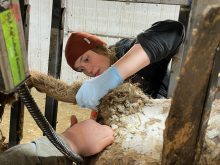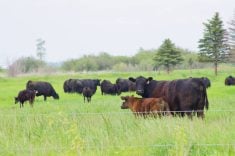A recent case of stillborn and weak beef calves was brought to my attention by a veterinarian who was working to diagnose the cause of calf mortality.
It’s another great example of how the use of the diagnostic laboratory was essential to solving the case.
The herd in question had approximately 140 cows, which were due to start calving in mid-March.
Read Also

Feds propose overhaul of chronic wasting disease control program
Chronic Wasting disease control program getting updated by Canadian Food Inspection Agency with feedback encouraged from producers.
The producer had four cows calve a week or two before expected, and the calves were a little smaller in size than expected. Although they were born alive, they died shortly after birth.
The local veterinarian thought that the nutrition of the cows was adequate but was a bit concerned that the cows weren’t being regularly vaccinated for the core vaccinations of infectious bovine rhinotracheitis (IBR) and bovine viral diarrhea virus (BVDV), both of which can be important causes of abortion and stillborn calves.
In this herd, the heifers were vaccinated annually, but the mature cow herd had not been vaccinated for approximately five years.
The producer was quick to recognize that something was amiss and worked with his local veterinarian to submit the calves to Prairie Diagnostic Services, our veterinary diagnostic laboratory in Saskatoon.
The calves that were sent into the lab were all small in size, fully haired and their first incisors were nearly erupted. This indicated that the calves were very close to full term at birth.
Trace mineral testing was performed on a sample of liver from each of the calves, and there were no significant trace mineral deficiencies identified.
The pathologist also tested the calves for a panel of potential bacteria, viruses and parasites that can cause abortion, and these tests were all negative as well.
However, the veterinary pathologists who examined the calves were able to identify the problem. All three calves that were examined had a defect in the heart.
These calves all had the most common congenital cardiac abnormality, which is a connection between the left side of the heart and the right side of the heart known as a ventricular septal defect. This particular “hole in the heart” meant that the calves’ hearts could not function properly and as a result they died shortly after being born.
Congenital cardiac defects are rare in cattle but are probably underdiagnosed.
You can imagine that a relatively small percentage of these types of still-born calves get submitted for a post-mortem, and as a result, many producers may be unaware that the calf’s death was due to a cardiac defect.
Slaughterhouse studies show that less than 0.2 per cent of cattle have cardiac defects, which also demonstrates that some of the animals affected by this problem can survive and not show significant clinical problems.
In many cases, this is just a matter of how severe the lesions are in the heart and the impact they have on the heart’s ability to function.
When the defect is of a significant size, it can allow blood to move from the left ventricle (where oxygenated blood is usually pumped to the rest of the body), back to the right side of the heart. This can eventually cause heart failure in the calf, which can occur near the time of birth or sometime later in life as the calf grows.
Calves with this abnormality may eventually show signs of heart failure if they are viable at birth or they may show almost no clinical signs except for a heart murmur.
We don’t completely understand what causes these heart defects in calves.
There is some evidence of hereditary transmission in Herefords and Limousins, but there may also be environmental factors at play.
The exact mode of inheritance, if genetics are involved, is still unclear.
In this herd, the local veterinarian submitted samples for parentage testing to see if a common sire could be identified. If one bull is the sire of all these affected calves, I would probably recommend culling that bull.
This case does highlight the importance of investigating unusual calf mortality to identify the cause of death.
If the calves are alive but showing symptoms of distress, especially when exercised, your veterinarian may be able to identify these types of defects by a physical examination of the affected live calf and listening to the heart and identifying a murmur.
Ultrasound exams may also be useful in identifying heart enlargement.
Postmortem examinations can reveal the defect but require a detailed dissection of the heart, which is sometimes difficult to accomplish in the field.
Submitting dead calves to the diagnostic laboratory helps to rule out other potential infectious causes and identify the problem.
Using parentage testing to identify if a common sire is involved may be necessary to explore a potential hereditary component.
John Campbell is a professor in the department of Large Animal Clinical Sciences at the University of Saskatchewan’s Western College of Veterinary Medicine.















